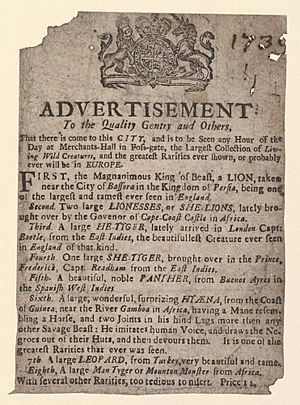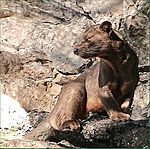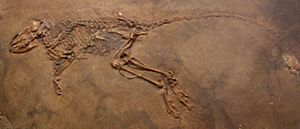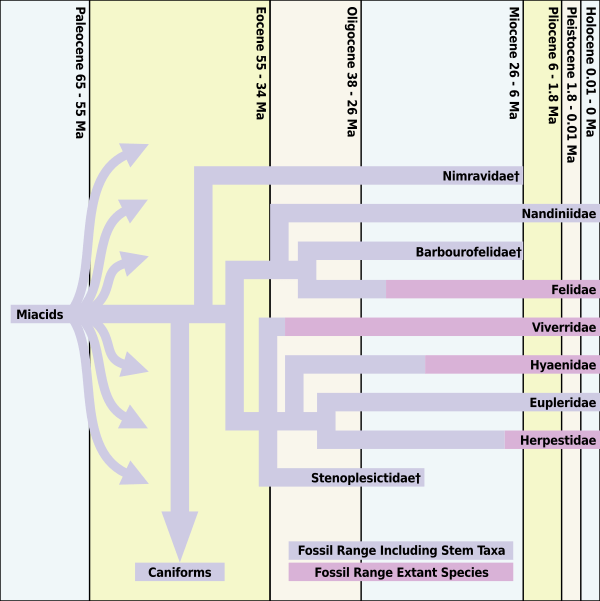Feliforms facts for kids
Quick facts for kids FeliformiaTemporal range: Eocene to Recent
|
|
|---|---|
 |
|
| Tiger (Panthera tigris) | |
| Scientific classification | |
| Kingdom: | |
| Phylum: | |
| Class: | |
| Order: | |
| Suborder: |
Feliformia
Kretzoi, 1945
|
Feliformia is a suborder in the mammal order Carnivora. It contains all the Felidae, which are cat-like animals. The suborder also contains the relatives of the cats, which includes hyaenas, civets, and more.
There are six families, twelve subfamilies, 56 genera and 114 species in the Feliformia suborder now.
Molecular phylogeny shows the Feliformia is monophyletic. The other suborder of Carnivora is the dog-like Caniformia.
Extant families

There are seven extant families, twelve subfamilies, 56 genera and 114 species in the Feliformia suborder. They range natively across all continents except Australia and Antarctica. Most species are arboreal or semi-arboreal ambush hunters. Target prey varies based on the species size and available food sources (with the larger species feeding mainly on small mammals and the smallest species feeding on insects or invertebrates).
An overview of each family is provided here. For detailed taxa and descriptions of the species in each family, follow the links to other articles and external references.
Family Eupleridae (the "Malagasy carnivorans") includes fossa, falanouc, Malagasy civet and Malagasy mongooses, all of which are restricted to the island of Madagascar. The eight species in the family exhibit significant variations in form. These differences initially led to the species in this family sharing common names with, and being placed in the different families of, apparently more similar species on the mainland (e.g. civets and mongoose).
The differences in form make it difficult to concisely summarise the species in this family. The range in size is as diverse as the range in form, with smaller species at less than 500 g (1 lb) and the largest species at up to 12 kg (26 lb). Some have retractile or semi-retractile claws (the fossa and the Malagasy civet) and others do not (the falanouc and Malagasy mongooses). They all tend to have slender bodies and pointed rostra (except the fossa, which has a blunt snout). Diet varies with size and form of the species and, like their mainland counterparts, ranges from small mammals, insects and invertebrates through to crustaceans and molluscs.

Family Felidae (domestic cats, tiger, lion, ocelot, etc.) are the best-known of "cat-like" carnivorans. There are 41 extant species, and all but a few have retractile claws. This family is represented on all continents except Australia (where domestic cats have been introduced) and the Antarctic. The species vary in size from the tiny black-footed cat (Felis nigripes) at only 2 kg (4.5 lb) to the tiger (Panthera tigris) at 300 kg (660 lb). Diet ranges from large to small mammals, birds and insects (depending on species size.)

Family Hyaenidae (hyenas and aardwolf) has four extant species and two subspecies. All show features of convergent evolution with canids, including non-retractile claws, long muzzles, and adaptations to running for long distances. They are extant in the Middle East, India and Africa. Hyenas are large, powerful animals, up to 80 kg (176 lb) and represent one of the most prolific large carnivorans on the planet. The aardwolf is much smaller at 27 kg (60 lb) and is a specialised feeder, eating mainly harvester termites.

Family Herpestidae (the mongooses, kusimanses, meerkat, etc.) has 32 species. Previously, these were placed in the family Viverridae. However, Wilson and Reeder (1993) established the herpestids as morphologically and genetically distinct from viverrids. They are extant in Africa, Middle East and Asia. All have non-retractile claws. They are smaller as a family, ranging from 1 kg (2.2 lb) to 5 kg (11 lb), and typically have long, slender bodies and short legs. Diet varies based on species size and available food sources, ranging from small mammals, birds to reptiles, insects and crabs. Some species are omnivorous, including fruits and tubers in their diet.

Family Nandiniidae (African palm civet) has only one species (Nandinia binotata), extant across sub-Saharan Africa. They have retractile claws and are slender-bodied, arboreal omnivores (with fruit making up much of their diet). They are relatively small with the larger males weighing up to 5 kg (11 lb).
Family Prionodontidae (the Asiatic linsangs) has two extant species in one genus. They live in Southern-East Asia. All are arboreal hypercarnivorans. They are the closest living relatives of the family Felidae.
Family Viverridae (the binturong, civets, genets and African linsang) has 30 extant species and all have retractile claws. They are extant in Southern Europe, Africa and Asia. They range in size from 500g (1 lb) up to medium-sized carnivorans at 14 kg (39 lb). They have long bodies and short legs and usually have long tails (some prehensile). Diet ranges from small mammals and insects through to crustaceans and molluscs. Many species, such the binturong, will eat plants as well.
Evolution
In the Middle Palaeocene (60 million years ago), Miacoidea appears. Miacoids were a group of paraphyletic taxa believed to be basal to Carnivora. They had Carnivora-like carnassials but lacked fully ossified auditory bullae. Miacids were small arboreal carnivorans and, based on their size (roughly that of mongooses), they probably fed on insects, small mammals and birds.
The miacoids are divided into two groups: the miacids, with a full complement of molars, and the viverravines with a reduced number of molars and more specialized carnassials. These dental differences resemble the difference between Caniforms (with more teeth) and Feliforms (with fewer teeth) but this may not mean evolutionary lineages. It was thought that Viverravidae was basal to the Feliforms. However, recent studies suggest this is not the case (Wesley-Hunt and John J. Flynn 2005).
In the Middle Eocene (about 42 mya), the miacids started to branch into two distinct groups of the order Carnivora: the Feliforms and Caniforms. The miacid precursors to the extant Feliforms remained forest-dwelling, arboreal or semi-arboreal ambush hunters, while the Caniform precursors were more mobile, opportunistic hunters. While it is clear that the first Feliforms appeared at this time, there is no clear common ancestor of the Feliform families in the fossil records. As forest dwellers, the early Feliforms were subject to more rapid decomposition in the absence of sedimentary materials, resulting in large gaps in the fossil records.
For more discussion on feliform evolution and the divergence from the caniforms, together with additional external references on this subject, see the articles on Carnivora, Miacoidea and Carnivoramorpha.
The diagram below presents a contemporary (2010) view of feliform evolution and familial relationships (cladogram) overlaid onto the geological time scale. The information presented is based on fossil records and systematic classifications. (Prionodontidae is not included.)
Phylogenetic tree
| Feliformia |
|
||||||||||||||||||||||||||||||||||||||||||||||||||||||
Images for kids
See also
 In Spanish: Feliformia para niños
In Spanish: Feliformia para niños







